the six big mass extinction events
By zteve t evans
Through out history Earth has suffered a series of mass extinction events that saw the continuation of life on Earth threatened. There has also been a number of lesser extinctions but this work concentrates on the main mass extinction events. First, we will briefly define a mass extinction event and then look at the five most devastating mass extinction events in history. Then the discussion will look at the sixth and ongoing mass extinction event and conclude with thoughts for the future.
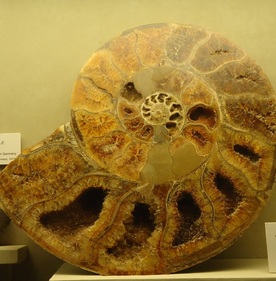 Fossilized Ammonite Shell - Public Domain
Fossilized Ammonite Shell - Public Domain
What is a mass extinction event?
Each extinction varied in intensity and cause but each time life on Earth adapted, evolved and bounced back. A mass extinction event is a time in history where an extraordinary large number of different species die at the same time or within a limited time
The most well known of these events was the Cretaceous-Tertiary extinction which wiped out most of the dinosaurs. Nevertheless, there have been four other mass extinctions, some more devastating than this event, where half or more of all species were estimated to have died.
The most devastating of these events occurred at the end of the Permian period when 96% of species were wiped out. This event and the Cretaceous-Tertiary extinction event are the two main mass extinctions so far.
There have also been a number of smaller scale mass extinctions. For example human activity has caused the extinction of many animal and plant species throughout history and in modern times. In time these will show in the fossil record as a mass extinction. In fact we are going through a sixth mass extinction of plants and animals caused by humans but how devastating that will prove to be only time can tell.
Each extinction varied in intensity and cause but each time life on Earth adapted, evolved and bounced back. A mass extinction event is a time in history where an extraordinary large number of different species die at the same time or within a limited time
The most well known of these events was the Cretaceous-Tertiary extinction which wiped out most of the dinosaurs. Nevertheless, there have been four other mass extinctions, some more devastating than this event, where half or more of all species were estimated to have died.
The most devastating of these events occurred at the end of the Permian period when 96% of species were wiped out. This event and the Cretaceous-Tertiary extinction event are the two main mass extinctions so far.
There have also been a number of smaller scale mass extinctions. For example human activity has caused the extinction of many animal and plant species throughout history and in modern times. In time these will show in the fossil record as a mass extinction. In fact we are going through a sixth mass extinction of plants and animals caused by humans but how devastating that will prove to be only time can tell.
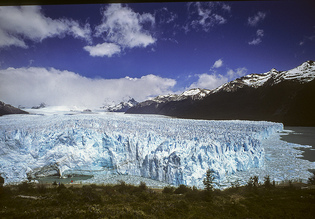 Ice sheet
Ice sheet
The Ordovician-Silurian mass extinction
The Ordovician-Silurian mass extinction occurred around 443 million years ago. This was the third most devastating extinction in the history of the Earth. A feature of this event was that there were two peaks in the mass deaths that occurred that were separated by hundreds of thousands of centuries.
During the Ordovician period which began about 495 million years ago most life on Earth was found in the sea. It was these marine creatures such as graptolites, brachiopods, and trilobites whose numbers were severely decimated. It is estimated that 85% of all life in the seas was wiped out.
Through different kinds of studies we know that the climate of the Earth has changed a number of times in the distant past for various reasons. When the climate goes through changes too fast many plants and animals cannot adapt fast enough to survive and mass extinctions occur. Such changes can result in changes to the atmosphere and the air breathed and changes to the chemicals in the water.
Experts believe the cause of this mass extinction event was an ice age which caused a gigantic sheet of ice to form in the southern oceans of the planet altering the chemical composition of the seawater.
The Ordovician-Silurian mass extinction occurred around 443 million years ago. This was the third most devastating extinction in the history of the Earth. A feature of this event was that there were two peaks in the mass deaths that occurred that were separated by hundreds of thousands of centuries.
During the Ordovician period which began about 495 million years ago most life on Earth was found in the sea. It was these marine creatures such as graptolites, brachiopods, and trilobites whose numbers were severely decimated. It is estimated that 85% of all life in the seas was wiped out.
Through different kinds of studies we know that the climate of the Earth has changed a number of times in the distant past for various reasons. When the climate goes through changes too fast many plants and animals cannot adapt fast enough to survive and mass extinctions occur. Such changes can result in changes to the atmosphere and the air breathed and changes to the chemicals in the water.
Experts believe the cause of this mass extinction event was an ice age which caused a gigantic sheet of ice to form in the southern oceans of the planet altering the chemical composition of the seawater.
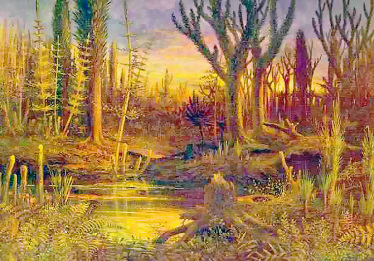 Artist impression of the Devonian period forests - Public Domain
Artist impression of the Devonian period forests - Public Domain
The Late Devonian mass extinction
The Devonian period began 417 million years ago with the mass extinction around 359 million years ago. It is estimated that three quarters of all species perished in what may not have been a single event but a series of extinctions that occurred over several million years.
During the Devonian period the land was extensively colonised by plants. As plants continued to evolve extensive forests gradually spread across the land and began affecting the atmosphere and soil.
The worst affected species were those living in the shallow seas with coral reefs dying off and not recovering for over 100 million years when new species of coral had evolved. During this time much of the seabed lost a lot of oxygen making it uninhabitable to most other forms of life except bacteria.
There may not have been a single cause but experts think that the new plants that evolved possibly changed the chemistry in the soil and atmosphere. Possible changes in sea level and impacts from asteroids may also have played a part.
The age of fishes
The Devonian period is also known as the "Age of Fishes" as the lineage of several fish species evolved during this period. The Earth enjoyed a warm climate with surface temperatures of the tropical regions similar to those today averaging around 30 Celsius. The sea levels were high and the water warm.
From growth rings from corals that lived in the Devonian period it is possible to tell that there was about 404 days in the year then as opposed to 365 today. By the end of the Devonian period about 359 million years ago the number of days in the year had fallen to about 396.
The Devonian period began 417 million years ago with the mass extinction around 359 million years ago. It is estimated that three quarters of all species perished in what may not have been a single event but a series of extinctions that occurred over several million years.
During the Devonian period the land was extensively colonised by plants. As plants continued to evolve extensive forests gradually spread across the land and began affecting the atmosphere and soil.
The worst affected species were those living in the shallow seas with coral reefs dying off and not recovering for over 100 million years when new species of coral had evolved. During this time much of the seabed lost a lot of oxygen making it uninhabitable to most other forms of life except bacteria.
There may not have been a single cause but experts think that the new plants that evolved possibly changed the chemistry in the soil and atmosphere. Possible changes in sea level and impacts from asteroids may also have played a part.
The age of fishes
The Devonian period is also known as the "Age of Fishes" as the lineage of several fish species evolved during this period. The Earth enjoyed a warm climate with surface temperatures of the tropical regions similar to those today averaging around 30 Celsius. The sea levels were high and the water warm.
From growth rings from corals that lived in the Devonian period it is possible to tell that there was about 404 days in the year then as opposed to 365 today. By the end of the Devonian period about 359 million years ago the number of days in the year had fallen to about 396.
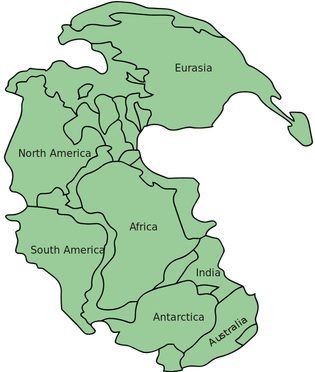 Map of Pangaea with modern continents outlined
Map of Pangaea with modern continents outlined
The Permian-Triassic mass extinction
The Permian period began around 290 million years ago with an ice age and finished with the most widespread and devastating mass extinction known in history 248 million years ago.
The Permian mass extinction has been called "The Great Dying” because 96% of all species on Earth were wiped out during this event. Today, all life on Earth evolved from the remaining 4% of species that survived that event.
As with other mass extinctions this was not a single event but seems to have occurred in two separate phases occurring over millions of years. Marine creatures were decimated and insects suffered their only ever mass extinction event.
A number of possible causes have been put forward to explain how this Great Dying came about. The impact of an asteroid, volcanic eruptions, a fall in oxygen levels in the air, or sea, more methane in the air, the rising or falling of sea levels or maybe any combination or all of these could have been the cause.
This was also the time on Earth when all the continents joined into one huge supercontinent known as Pangaea, which means “the entire Earth” so there was a lot of geological or volcanic activity. With the warming of the planet causing the ice to melt many parts of this supercontinent became dry and arid. Oxygen levels also dropped from their highest of 35% to 15% of the total atmosphere. Today, in comparison, oxygen content is 21%.
The great mass extinction of the Permian period heralded the beginning of the Triassic period.
The Permian period began around 290 million years ago with an ice age and finished with the most widespread and devastating mass extinction known in history 248 million years ago.
The Permian mass extinction has been called "The Great Dying” because 96% of all species on Earth were wiped out during this event. Today, all life on Earth evolved from the remaining 4% of species that survived that event.
As with other mass extinctions this was not a single event but seems to have occurred in two separate phases occurring over millions of years. Marine creatures were decimated and insects suffered their only ever mass extinction event.
A number of possible causes have been put forward to explain how this Great Dying came about. The impact of an asteroid, volcanic eruptions, a fall in oxygen levels in the air, or sea, more methane in the air, the rising or falling of sea levels or maybe any combination or all of these could have been the cause.
This was also the time on Earth when all the continents joined into one huge supercontinent known as Pangaea, which means “the entire Earth” so there was a lot of geological or volcanic activity. With the warming of the planet causing the ice to melt many parts of this supercontinent became dry and arid. Oxygen levels also dropped from their highest of 35% to 15% of the total atmosphere. Today, in comparison, oxygen content is 21%.
The great mass extinction of the Permian period heralded the beginning of the Triassic period.
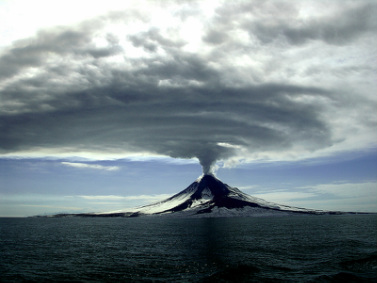 Volcanic fumes
Volcanic fumes
The Triassic-Jurassic mass extinction
The Triassic-Jurassic mass extinction happened about 200 million years ago in 2 or 3 phases during the final 18 million years of the Triassic period. The Triassic period followed the most devastating mass extinction event ever that happened towards the end of the Permian period. A number of factors have been blamed for causing this including asteroid strikes, flood basalt eruptions and climate change. Already severely weakened by the Permian mass extinction, life on Earth struggled to make a comeback, but it did.
The climate during the Triassic Period was generally warm with great deserts stretching across land masse in places and verdant, fertile forests in other places and the seas were warm. The polar regions were warm with lush forests growing across them.
The previous extinctions had left gaps in life on Earth which gave opportunities for new creatures to evolve and fill them. This period saw the evolution of the first mammals and dinosaurs.
The supercontinent of Pangaea began to break apart and the pieces move away from each other. The Triassic period ended as it had started with another mass extinction of species about 200 million years ago.
The Triassic-Jurassic mass extinction happened about 200 million years ago in 2 or 3 phases during the final 18 million years of the Triassic period. The Triassic period followed the most devastating mass extinction event ever that happened towards the end of the Permian period. A number of factors have been blamed for causing this including asteroid strikes, flood basalt eruptions and climate change. Already severely weakened by the Permian mass extinction, life on Earth struggled to make a comeback, but it did.
The climate during the Triassic Period was generally warm with great deserts stretching across land masse in places and verdant, fertile forests in other places and the seas were warm. The polar regions were warm with lush forests growing across them.
The previous extinctions had left gaps in life on Earth which gave opportunities for new creatures to evolve and fill them. This period saw the evolution of the first mammals and dinosaurs.
The supercontinent of Pangaea began to break apart and the pieces move away from each other. The Triassic period ended as it had started with another mass extinction of species about 200 million years ago.
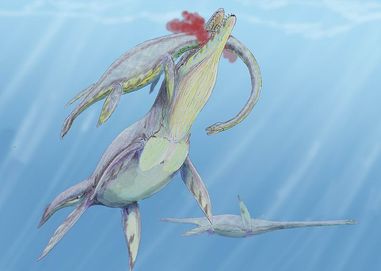 Mosasaurs and plesiosaurs died out by the end of the Cretaceous
Mosasaurs and plesiosaurs died out by the end of the Cretaceous
The Cretaceous-Tertiary mass extinction
The Cretaceous period began about 142 million years ago and ended 65 million years ago with a mass extinction of life, known as the Cretaceous-Tertiary mass extinction or sometimes the K/T extinction. This is probably the most widely known of the mass extinctions as it wiped out most of the dinosaurs. In fact many other organisms also were wiped out such as ammonites, the remaining pterosaurs and flowering plants.
Some of these organisms are believed to have been struggling for survival for several million years because of flood basalt eruptions and severe falls in sea level. The end came when the Earth was hit by a comet, or large asteroid, that crashed near the Yucatan Peninsula, Mexico. It was not necessarily the impact that caused the extinction but the dust it threw into the atmosphere which blocked out the sun.
Up until the Cretaceous climate had been warm with no ice in the polar regions. During this period sea levels were at their highest and vast tracts of land that are above water today such as the Midwest of The United States of America and the south of England were underwater.
As the North and South American continents separated and moved away from Europe and Africa the Atlantic Ocean grew wider. During this time India was an island and began to move northwards towards Asia. This was also the time when the Indian Ocean was formed. The mass extinction saw the end of the Cretaceous period and the beginning of the Palaeocene epoch.
The Cretaceous period began about 142 million years ago and ended 65 million years ago with a mass extinction of life, known as the Cretaceous-Tertiary mass extinction or sometimes the K/T extinction. This is probably the most widely known of the mass extinctions as it wiped out most of the dinosaurs. In fact many other organisms also were wiped out such as ammonites, the remaining pterosaurs and flowering plants.
Some of these organisms are believed to have been struggling for survival for several million years because of flood basalt eruptions and severe falls in sea level. The end came when the Earth was hit by a comet, or large asteroid, that crashed near the Yucatan Peninsula, Mexico. It was not necessarily the impact that caused the extinction but the dust it threw into the atmosphere which blocked out the sun.
Up until the Cretaceous climate had been warm with no ice in the polar regions. During this period sea levels were at their highest and vast tracts of land that are above water today such as the Midwest of The United States of America and the south of England were underwater.
As the North and South American continents separated and moved away from Europe and Africa the Atlantic Ocean grew wider. During this time India was an island and began to move northwards towards Asia. This was also the time when the Indian Ocean was formed. The mass extinction saw the end of the Cretaceous period and the beginning of the Palaeocene epoch.
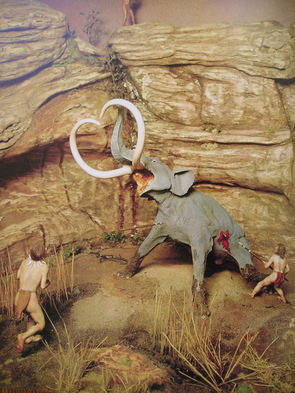 Humans hunting
Humans hunting
The Anthropocene mass extinction
The sixth mass extinction event is currently believed to be happening now. It has more than one name which seems to depend on the experts who are discussing it. Some call it The Pleistocene-Holocene Event or the Holocene event and others call it the Anthropocene, or the age of the humans, mass extinction event. It is named after humans because human activity is causing it. For our purpose we shall call it the Anthropocene mass extinction event.
This extinction began when humans began to migrate around the planet around 100,000 years ago. Over the last 500 years there has been a 25% decline in the populations of all species caused by human activity, though some groups of species have fared worse than others. Mammals, birds, reptiles, amphibians, fish, birds, insects and many species of flora are under threat and these are just the ones we know about. There are many other species hidden in the seas, or forests, mountains and remote areas we just do not know about. There are also fauna and flora we cannot see with the human eye that need a microscope to view, but many species of animals, insects, birds and fish depend on for them their existence.
The causes are many, but killing animals for the resources they supply such as food, clothing, tusks, pelts, body parts, pleasure and much more are taking a huge toll on the fauna of the planet. This does not just apply to the attractive, charismatic or cuddly and cute animals but also the less human favoured creatures too.
Destruction of the forests and other habitats by logging, farming, road building, house and industrial building, pollution of air, sea and land and much more is beginning to take a toll that can be seen and measured. There is also human induced global warming which is changing the planet and adversely affecting the flora and flora.
Thoughts for the future!
One of the first great rules of Earth biology is that no species lasts forever. All mass extinctions result in great volumes of death which leaves a void. This void, may, over millions of years, be filled by a few survivor species, or new species may evolve to take advantage of the gap.
Humans may well scientifically observe, scientifically document, and write endless scientific papers while witnessing our own extinction as well as that of most other living organisms. To prevent is probably too late but to lessen, or at least survive, may be the best we can hope for, deserved or not. Thoughts for the future indeed!
© 07/08/2014 zteve t evans
The sixth mass extinction event is currently believed to be happening now. It has more than one name which seems to depend on the experts who are discussing it. Some call it The Pleistocene-Holocene Event or the Holocene event and others call it the Anthropocene, or the age of the humans, mass extinction event. It is named after humans because human activity is causing it. For our purpose we shall call it the Anthropocene mass extinction event.
This extinction began when humans began to migrate around the planet around 100,000 years ago. Over the last 500 years there has been a 25% decline in the populations of all species caused by human activity, though some groups of species have fared worse than others. Mammals, birds, reptiles, amphibians, fish, birds, insects and many species of flora are under threat and these are just the ones we know about. There are many other species hidden in the seas, or forests, mountains and remote areas we just do not know about. There are also fauna and flora we cannot see with the human eye that need a microscope to view, but many species of animals, insects, birds and fish depend on for them their existence.
The causes are many, but killing animals for the resources they supply such as food, clothing, tusks, pelts, body parts, pleasure and much more are taking a huge toll on the fauna of the planet. This does not just apply to the attractive, charismatic or cuddly and cute animals but also the less human favoured creatures too.
Destruction of the forests and other habitats by logging, farming, road building, house and industrial building, pollution of air, sea and land and much more is beginning to take a toll that can be seen and measured. There is also human induced global warming which is changing the planet and adversely affecting the flora and flora.
Thoughts for the future!
One of the first great rules of Earth biology is that no species lasts forever. All mass extinctions result in great volumes of death which leaves a void. This void, may, over millions of years, be filled by a few survivor species, or new species may evolve to take advantage of the gap.
Humans may well scientifically observe, scientifically document, and write endless scientific papers while witnessing our own extinction as well as that of most other living organisms. To prevent is probably too late but to lessen, or at least survive, may be the best we can hope for, deserved or not. Thoughts for the future indeed!
© 07/08/2014 zteve t evans
References and Attributions
Copyright August 7th, 2014 zteve t evans
Copyright August 7th, 2014 zteve t evans
- Kronosaurus hunt1DB CC BY 3.0 Dmitry Bogdanov - [email protected]
- Pangaea continents - CC BY-SA 3.0 - en:User:Kieff - File:Pangaea continents.png
- Extinction event - Wikipedia, the free encyclopedia
- BBC Nature - Big Five mass extinction events
- Mass extinctions | Natural History Museum
- Mass extinctions | Natural History Museum
- The Extinction Crisis - Center for Biological Diversity
